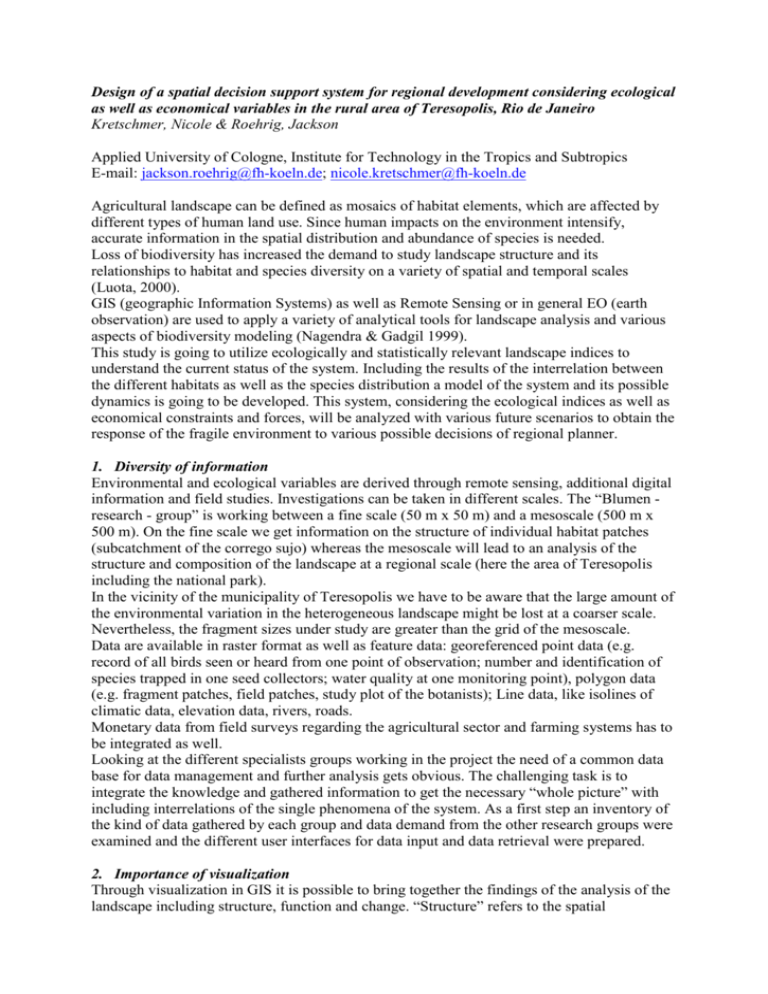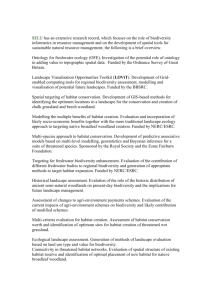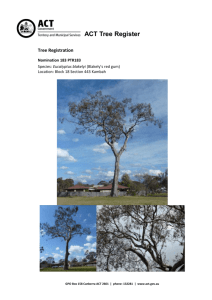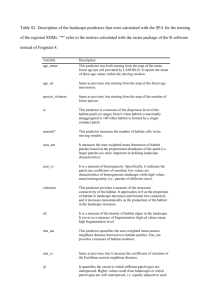Design of a spatial decision support system for regional
advertisement

Design of a spatial decision support system for regional development considering ecological as well as economical variables in the rural area of Teresopolis, Rio de Janeiro Kretschmer, Nicole & Roehrig, Jackson Applied University of Cologne, Institute for Technology in the Tropics and Subtropics E-mail: jackson.roehrig@fh-koeln.de; nicole.kretschmer@fh-koeln.de Agricultural landscape can be defined as mosaics of habitat elements, which are affected by different types of human land use. Since human impacts on the environment intensify, accurate information in the spatial distribution and abundance of species is needed. Loss of biodiversity has increased the demand to study landscape structure and its relationships to habitat and species diversity on a variety of spatial and temporal scales (Luota, 2000). GIS (geographic Information Systems) as well as Remote Sensing or in general EO (earth observation) are used to apply a variety of analytical tools for landscape analysis and various aspects of biodiversity modeling (Nagendra & Gadgil 1999). This study is going to utilize ecologically and statistically relevant landscape indices to understand the current status of the system. Including the results of the interrelation between the different habitats as well as the species distribution a model of the system and its possible dynamics is going to be developed. This system, considering the ecological indices as well as economical constraints and forces, will be analyzed with various future scenarios to obtain the response of the fragile environment to various possible decisions of regional planner. 1. Diversity of information Environmental and ecological variables are derived through remote sensing, additional digital information and field studies. Investigations can be taken in different scales. The “Blumen research - group” is working between a fine scale (50 m x 50 m) and a mesoscale (500 m x 500 m). On the fine scale we get information on the structure of individual habitat patches (subcatchment of the corrego sujo) whereas the mesoscale will lead to an analysis of the structure and composition of the landscape at a regional scale (here the area of Teresopolis including the national park). In the vicinity of the municipality of Teresopolis we have to be aware that the large amount of the environmental variation in the heterogeneous landscape might be lost at a coarser scale. Nevertheless, the fragment sizes under study are greater than the grid of the mesoscale. Data are available in raster format as well as feature data: georeferenced point data (e.g. record of all birds seen or heard from one point of observation; number and identification of species trapped in one seed collectors; water quality at one monitoring point), polygon data (e.g. fragment patches, field patches, study plot of the botanists); Line data, like isolines of climatic data, elevation data, rivers, roads. Monetary data from field surveys regarding the agricultural sector and farming systems has to be integrated as well. Looking at the different specialists groups working in the project the need of a common data base for data management and further analysis gets obvious. The challenging task is to integrate the knowledge and gathered information to get the necessary “whole picture” with including interrelations of the single phenomena of the system. As a first step an inventory of the kind of data gathered by each group and data demand from the other research groups were examined and the different user interfaces for data input and data retrieval were prepared. 2. Importance of visualization Through visualization in GIS it is possible to bring together the findings of the analysis of the landscape including structure, function and change. “Structure” refers to the spatial relationship between distinctive ecosystems or landscape elements, i.e. the distribution of materials and species in relation to the sizes, shapes and numbers of components. “Function” refers to the interactions between the spatial elements, e.g. the flow of materials and organisms between the component ecosystems. “Change” refers to change in the structure and function of ecological mosaic with time (Turner, 1989). The use of GIS in the project has two functions: firstly it will serve the involved researchers to get a better understanding of the complex study area and support each group with special applications focused on spatial analyst tools for analyzing their data in space and to find relationships between them; secondly the finial product will contain all results, database as well as analysis which will be needed by decision markers and furthermore it can be used for educational purposes. Such a system is able to advance the sensibility of the human beings influencing the system with their actions. 3. Possibilities of spatial analysis and modeling The first spatial analysis done by the GIS group has the objective to analyze the area on a local as well as regional scale concerning habitat patches, habitat structure and habitat composition. Habitat patches comprising the landscape are not self-evident; they must be defined relative to the phenomenon under consideration. A patch can be defined as a relative homogenous area that differs from its surroundings. Normally, patches in a landscape are plant and animal communities, e.g. assemblages of species. Habitat patches as well as habitat structure and habitat composition are being investigated on a regional and local scale with the help of remote sensing techniques (Landsat as well as Ikonos Images are being classified). Habitat composition refers to features associated with the presence and amount of each patch type within the landscape, but without being spatially explicit. The physical distribution or spatial character of habitat patches is being expressed by habitat structure. A number of landscape structure metrics can be formulated either in terms of the individual patches or in terms of the whole landscape. In general the increasing intensification of agriculture, between-habitat structure has become sharper and habitats more fragmented. Furthermore sharpening of habitat boundaries and fragmentation of terrestrial habitats into agricultural purposes has negative effects on biodiversity (Luoto, 2000). With the program Fragstats the common landscape metrics of the region under study are being investigated. Through spatial analysis dependencies between landscape metrics, topology, geomorphology, climatic information and species distribution will be gained. For example topographical and habitat structural variables can be analyzed together with biologically primary variables (food resources and habitat composition). All this might be included in a species distribution model. Spatial analysis by GIS techniques is a complementary approach in the assessment of habitat and biological diversity at the landscape level. It can provide support and guidelines for decision makers. Looking at the five different projects of the BMBF Mata Atlantica program the analysis of habitat composition in the different study areas including the topographical characteristics of habitats could be an interesting result for comparison. 4. Simulation of the System taking different possible future scenarios into account Knowing the status and interrelationships of the system, its dynamics will be simulated with the program “Powersim Studio”. Using system dynamics simulations allows us to see not just events, but also patterns of behavior over time. The behavior of a system often arises out of the structure of the system itself, and behavior usually changes over time. Understanding patterns of behavior, instead of focusing on day-to-day events, can offer a radical change in perspective. It shows how a system's own structure is the cause of its successes and failures. This structure is represented by a series of causally linked relationships. The implication is that decisions made have consequences, some of which are intentional and some are not. Some of these consequences will be seen immediately while others might not be seen for several years. System dynamics simulations are good at communicating not just what might happen, but also why. This is because system dynamics simulations are designed to correspond to what is, or might be happening, in the real world (Manual Powersim: Introduction to System Dynamics). The simulation of our system due to different regional planning scenarios requires firstly a “system thinking” from the whole group. In systems thinking we look for interrelationships among the different system elements. Here the knowledge of each scientific area is needed to understand the interrelations or dependencies for setting up the real world system. We will have cause – effect relationships as well as causal loops, feedbacks and delays in reactions. For the design of the model the definition of the problem as well as the model boundaries are essential. The corresponding variables and reference modes (behavior of the variables over time) have to be described, too. With this information a conceptual model design is possible and should be adjusted from all participating groups before the Model Formalization and Simulation. Different possible future scenarios of regional planning or other changes in the system have to set up. Through the simulation changes in the system due to different management or climatic influences will be observed and have to be evaluated in terms of sustainability of the region. Since we are not in the state of knowing the interrelationships of the system elements no example can be given so far. This will be a future perspective. References: Luoto, Miska (2000): Spatial analysis of landscape ecological characteristics of agricultural areas in Finland by GIS. Fennia 178:1,pp 15-54, Helsinki Naganda,H. & M.Gadgil (1999): Satellite imagery as a tool for monitoring species diversity: an assessment. Journal of Applied Ecology 36, 388-397 Turner, M.G. (1989): Landscape ecology: The Effect of Pattern on Process. Annual Review of Ecological Systematics 20, 171-197.







